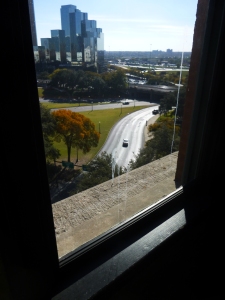This is the first of five stories written to mark the 50th anniversary of the assassination of President John F. Kennedy. Scroll down for more.
Published in the Nelson Mail, 23 Nov 2013.
At the corner window on the seventh floor of the Texas School Book Depository I hesitate as I aim an imaginary rifle at a car on the street below.

My view from the 7th floor, exactly above the glassed off spot where Oswald fired. (All photos on this page by Michael Day)
It is virtually the same view as Lee Harvey Oswald had when he fired at President John F. Kennedy on 22 November 1963, the only difference being I am one floor higher.
“I could easily hit it,” I say, but JFK was a hero of mine and I don’t forget that the event was the murder of a real person, not just some fictional identity.
I am astonished that over all these years so many have doubted that a competent marksman like Oswald would have had trouble hitting his target.
A security man looks at me, and smiles. He had heard my accent and adopts the usual friendly response to “Ossies”.
We are alone on the seventh floor. Nobody else seems to have spotted the rather obscure stairs up from Sixth Floor Assassination Museum, with its extensive and fascinating collection, where visitors peer at the glass partition that prevents them from getting the view Oswald had from the corner.
I leave the building and cross to the lawn just a couple of metres from the road where a white X marks the killing spot. Incredibly to me, some people stand on the X, smile, and have their photos taken– as if a horrible murder is some celebrity event.

Ernest Brandt, 86, told me he as wearing the same hat he had on when he witnessed the assassination. I prompted the reporter to ask him about his hat.
I interview an elderly man, who tells me that he and a friend with him today were eyewitnesses to the assassination.
Ernest Brandt, 86, of Dallas says he had been standing within metres of the president when the shots were fired.
“I thought it was motorcycles backfiring,” Mr Brandt says. “When I realised it was gunfire I ran behind a tree– it scared the hell out of me.”
Pointing to his less talkative friend, John Templin, 74, he says: “He saw his head explode.”
Mr Brandt shows me a photograph taken of him at the site just before the assassination. “See this hat,” he says, pointing to his trilby. “That’s the same hat as in the photograph.”
When asked by a newly arrived reporter why he returns to the site, he says: “It makes me feel like a celebrity, it makes me feel like Michael Jackson.”
I walk up to the grassy knoll and encounter a man wearing a sandwich board proclaiming on the front: “Six reasons why our fascist government killed JFK,” and on the back: “JFK’s killing & 9/11 R both government conspiracies.”

A white X on the road marks the place where the president was hit by two bullets fired by Lee Harvey Oswald, 24.
The atmosphere has a crackpot, and even sleazy feel. Speakers accuse institutions, politicians, the mafia and the Cubans.
I front one man: “Why hasn’t somebody involved in the conspiracy spilt the beans over the last 50 years?” He replies with a glint in his eye: “They killed everybody who knew.”
I wander off to makeshift memorial and meet Sharen Dyche of North Carolina, who places a bouquet of flowers under a little American flag. As a token of my respect, I place there a small souvenir kangaroo.
“My late husband believed the assassination was a conspiracy, and so do I,” Mrs Dyche says.
I tell her I think Oswald was the lone assassin and she graciously accepts that I have a different view. I tell her I admired the president very much and that like many alive at the time, I remember where I was — leaving a tennis lesson–when I heard and at first disbelieved the news. “He saved us from a nuclear war,” I say, recounting to her how I had heard the tape of the president rejecting the advice of the military to start hostilities over Cuba in 1962.
I walk a block to the official Dallas memorial to the president. Funded by local citizens and approved by the president’s widow, Jacqueline Kennedy, it has soaring white stone walls, elevated on columns nearly a metre from the ground.
I enter the enclosure and find a shining, black granite square with the words “John Fitzgerald Kennedy” engraved in gold.




1 comment
Comments feed for this article
November 16, 2013 at 9:28 am
ghislaine.salter@gmail.com
Thank you Michael. I found this very interesting. It is not probably something I would do but enjoyed travelling with you on your discovery